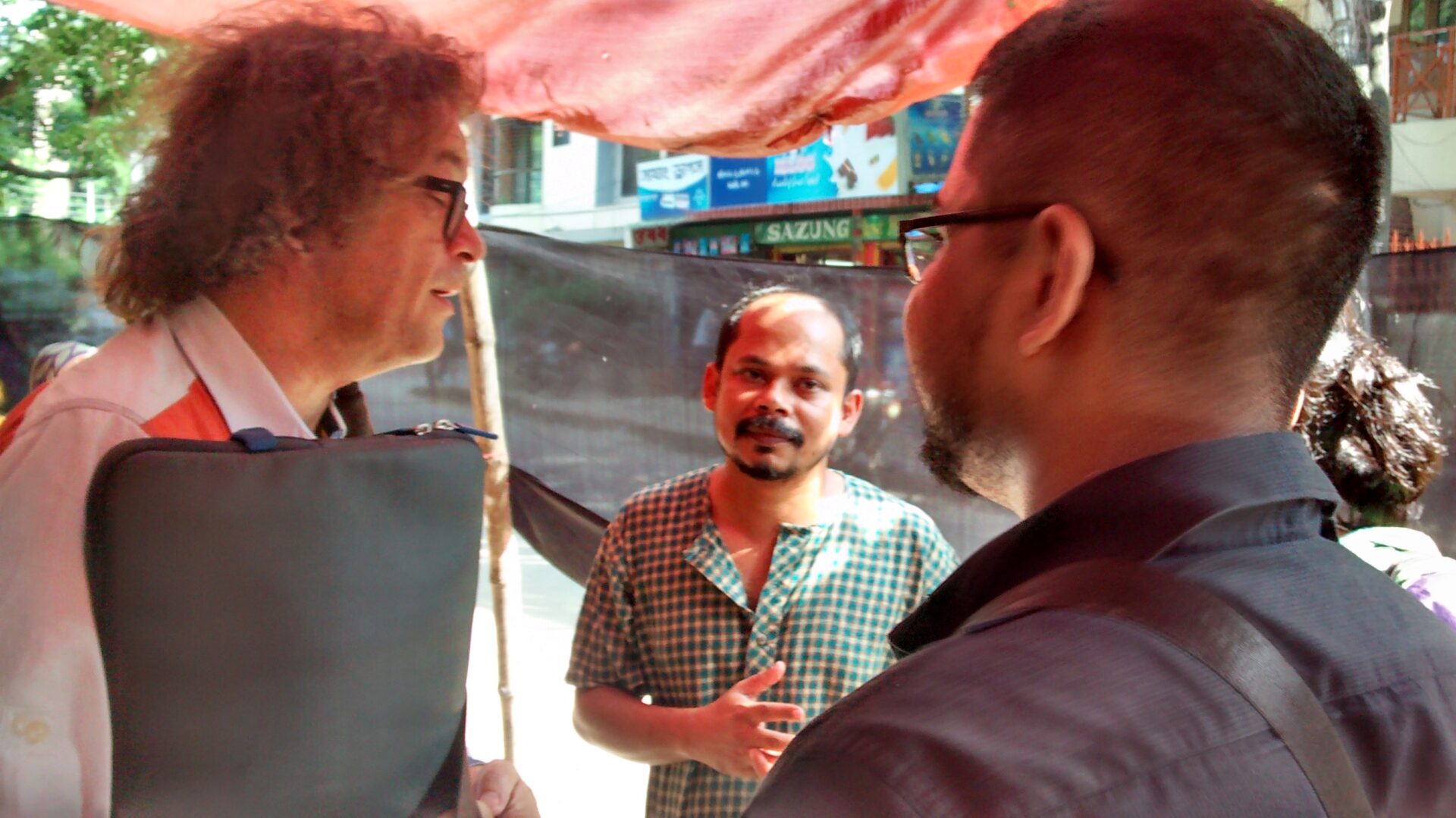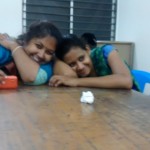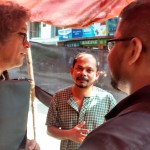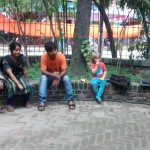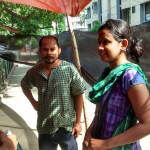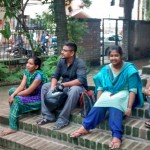Dialogue Dhaka art center 12th of July
Today we met with the artists in Dhaka art center, after asking the question last week to choose a group in Dhaka to work with, and make contact with these people.
Emran is telling the group about his meeting with the Rickshaw drivers. Martijn told him about really making contact with people before photographing or painting them. First the connection, then go on. To make a connection is more then asking their name or how they are. It is about looking in the eyes of the other, being genuinely interested in that person. If you are doing it as a trick, the other will feel it immediately. So Emran and Martijn talked to rikshaw drivers about their life, their families. Someone shared that he had a girlfriend that left him for another man, another one told about his life in the country, where he lives with his family half of the month when there is work on the land. We will be portraying only 50 drivers of 350.000, but this will contribute to showing them as a human being instead of just the back of a rikshaw driver. Emran, Khairul and Sharmeen will take rickshaw drivers and homeless as a group. They have gone to them, and found out some stories, like the rickshaw driver who does not want to take fat customers. They are thinking what angle they want to take for their project. The first works are posted in the facebook group.
Tanvir Jalal had no thoughts on which group, and he went onto the streets with a blank mind, looking around him. There he arrived at a construction site, and he saw female construction workers there. They were very muscled, and worked as hard as the men. Some had children around them, playing or helping. He went to talk to them, and found out that the women are working together with their husbands, and take their children there to. They work everyday, and get around 250 takka, which is 2,50 euro per day. Tanvir was interested in them, it feels like they are feminists in their way, with a high working skill. Martijn says that is his way of finding a group is very interesting, since he went out with an open mind, really looking around him and thus finding something he did not notice before. Martijn likes to go with him one day.
Dipa mahbuba yasmin wants to work with spiritual ‘healers / fortunetellers’, called Bangla Pier in Bangla. that people consult from their believe in that they can help them. She thinks of this as superstition, and has the idea that these ‘fortunetellers’ are frauds that abuse people who put their faith in them. We talk about the importance of meeting them with an open mind, and more then asking the question ‘What do I feel about them?’ it is helpful to ask the question ‘What do these people contribute or distract from society? What is their function in society?’ Another question Martijn has for Dipa is ‘What makes you interested in those people, what is your connection?’ She answers that she feels for the victims. So Sumon raises the question whether she should focus also on the visitors, and not only the Bangla Pier.
Moon and Trina started to connect with streetworkers, who are working in front of their university. They see them everyday, and still do not know anything about them. So they started making contact with some of them, and found it took a long time before they wanted to say anything about themselves. After some time they told some things about their family life.
Ali wants to work with the gay community in Bangladesh. He volunteers with the Boys of Bangladesh, an NGO that helps raising awareness about being gay in Bangladesh. He finds that is possible to be gay and admit it in Bangladesh, but only underground. There is still an old law, 377, against sodomy, on which grounds people can go to the police and file a complaint because someone is gay. Politically last year the government of Bangladesh made a statement that in Bangladesh there are no homosexuals. And in social life you also do not know how people will react when you say you are gay. There is a lot of bullying, and also misunderstanding. People think that being gay means you want to be a woman. Also in Dhaka there is a gay community and possibilities to be yourself underground. In other cities this is not possible. Ali likes to contribute to the understanding of being gay, and also make gays in Bangladesh ware that there are possibilities to live more free. Martijn and Sabya will go with him to the NGO and also to the hidjira community.
One group is unable to come due to the traffic situation in Dhaka: Kollo, Apurbo and Jhumu.
As a subject they choose the cleaners colony and their lives, believes, and philosophies. In the cleaner colony, cleaners live together as a big group. They have their own society, in which they marry and have children. They are paid by house-owners and a little bit by the government.
Umma Shohag has chosen the street children as a group. She has been communicating with them for a long time, and being with them makes her happy.
Ali asks Martijn on his definition of homeless, since he himself found them to be so different in Europe then here in Bangladesh. Martijn answers that there being homeless in different countries can have a completely different meaning, so it is impossible to make a definition. Thats why we try to show these differences in the Homeless of the World project. What we have encountered in Bangladesh are clean people, who look beautiful and are working or looking for work. In Holland there is no need to live on the street, and there is enough help. So there are the people who are drug-addicts, and psychiatric patients who live on the streets. In Sao Paulo homeless are living like a tribe, nomads, living together in groups and doing work on the streets.
Martijn asks the group to think about what we can do with all the works, to make a real contribution to the Bangladesh society. It is always nice to have an exposition in a gallery, where everybody can say ‘How nice, this work’ and have a drink. But that will not make any difference in society. Emran thought about this and likes to have an exposition in an unfinished building, like open air. We talk about the possibility to engage the people we work with with the people we will invite to see our works. The group think it possible to mix these groups. Then we could choose some places where the people we worked with feel at ease, and invite others to the exposition there. Sumon proposes to have exhibitions of 3 or 4 hours, and have them at four places. It seems important to invite press there beforehand. The places should be public domain, like a rickshaw garage, in an easy accessible place. We all think about good places, and our connections of who we want to invite.
Emran asks the question on what deadline the group thinks is good for finishing the work. As There is the festival in 2 weeks, where many people in Dhaka will be outside town, we propose the last week of august as a good moment. We can chose the dates and start contacting the press already.
Next week Saturday 19th of July we meet again at 16 in Dhaka art center. Meanwhile everybody comes up with their group or makes further connection and work. We all post in the Facebook group Dhaka online exchange platform.
